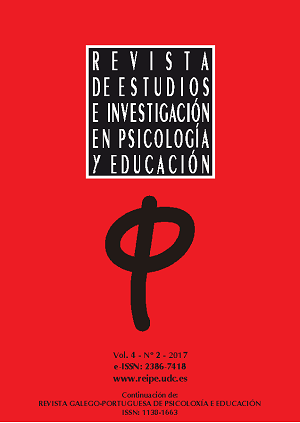Ability of architecture students to rotate urban maps
Main Article Content
Abstract
Keywords:
Downloads
Article Details
References
Alias, M., Black, T. R., & Gray, D. E. (2002). Effect of instructions on spatial visualisation ability in civil engineering students. International Education Journal, 3, 1-12.
Alonso, M., & Campos, A. (2013). Las imágenes mentales de los estudiantes de ciencias y ciencias sociales. In R. González Cabanach, R. Fernández Cervantes, F. Fariña, M. Vilariño, & C. Freire (Eds.), Psicología y salud I: Educación, aprendizaje y salud (pp. 121-125). A Coruña: GEU.
Aretz, A. J. (1991). The design of electronic map displays. Human Factors, 33, 85-101.
Arnheim, R. (1979). Visual thinking in education. In A. A. Sheikh, & J. T. Shaffer (Eds.), The pontential of fantasy and imagination (pp. 215-223). New York: Brandon House.
Blajenkova, O., Kozhevnikov, M., & Motes, M. A. (2006). Object-spatial imagery: A new self-report imagery questionnaire. Applied Cognitive Psychology, 20, 239-263. https://doi.org/ 10.1002/acp.1182
Blazhenkova, O., & Kozhevnikov, M. (2009). The new object-spatial-verbal cognitive style model: Theory and measurement. Applied Cognitive Psychology, 23, 438-663. https://doi.org/ 10.1002/acp.1473
Campos, A., Pérez-Fabello, M . J. & Díaz, P. (2000). Gimnasia rítmica: La imagen mental de novatos y expertos gimnastas. Revista de Psicología del Deporte, 9, 87-93. http://www.rpd-online.com/article/view/62
Campos-Juanatey, D. (2015). Casco Histórico de Lugo: Diseño de paneles turísticos y “You-are-here maps”. Actas del IX Congreso Internacional Virtual Turístico y Desarrollo. http://www.eumed.net/eve/9turydes-pon.html
Campos-Juanatey, D. (2016). Diseño de mapas you-are-here. Señalización de los centros históricos de las capitales gallegas. Santiago de Compostela: Andavira Editora.
Campos-Juanatey, D., Pérez-Fabello, M. J., & Campos, A. (en prensa). Differences in image rotation between undergraduates from different university degrees. Imagination, Cognition and Personality.
Ceci, S. J., Williams, W. M., & Barnett, S. M. (2009). Women´s underrepresentation in science: Sociocultural and biological considerations. Psychological Bulletin, 135, 218-261. https://doi.org/ 10.1037/a0014412
Coluccia, E., Iosue, G., & Brandimonte, M. A. (2007). The relationship between map drawing and spatial orientation abilities: A study of gender differences. Journal of Environmental Psychology, 27, 135-144. https://doi.org/10.1016/j.jenvp.2006.12.005
Cooper, L. A. (1975). Mental rotation of random two-dimensional shapes. Cognitive Psychology, 7, 20-43. https://doi.org/10.1016/0010-0285(75)90003-1
Cooper, L. A., & Shepard, R. N. (1973). Chronometric studies of the rotation of mental images. In W. G. Chase (Eds.) Visual information processing (pp. 75-176). New York: Academic Press.
González, M. A., Dopico, J., Iglesias, E., & Campos, A. (2006). Expertos y no expertos deportistas: Diferencias en imagen mental del movimiento. Cuadernos de Psicologíadel Deporte, 6, 6-10.
Harris, R. M. (1967). The Rand-McNally handbook of map and globe usage. Chicago: Rand-McNally.
Hyde, J. S., & Lindberg, S. M. (2007). Facts and assumptions about the nature of gender differences and the implications for gender equity. In S. S. Klein (Ed.), Handbook for achieving gender equity through education (pp.19-32). Mahwah: Lawrence Erlbaun Associates.
Kosslyn, S. M., & Koenig, O. (1992) Wet mind: The new cognitive neuroscience. New York: Free Press.
Kozhevnikov, M., Blazhenkova, O., & Becker, M. (2010). Trade-of in object versus spatial visualization abilities: Restriction in the development of visual-processing resources. Psychonomic Bulletin & Review, 17, 29-35. https://doi.org/.10.3758/PBR.17.1.29
Kozhevnikov, M., Hegarty, M., & Mayer, R. E. (2002). Revising the visualizer-verbalizer dimension: Evidence for two types of visualizers. Cognition and Instruction, 20, 47-77. https://doi.org/10.1207/S1532690XCI2001_3
Kozhevnikov, M., Kosslyn, S. M., & Shepard, J. (2005). Spatial versus object visualizers: A new characterization of visual cognitive style. Memory & Cognition, 33, 710-726. https://doi.org/ 10.3758/BF03195337
Levine, M. (1982). You-are-here maps: "Psychological considerations". Environment and Behavior, 14, 221-237. https://doi.org/10.1177/0013916584142006
Metzler, J., & Shepard, R. N. (1974). Transformational studies of the internal representation of three-dimensional objects. In R. Solso (Eds.) Theories in cognitive psychology: The Loyola Symposium (pp. 147-201). Hillsdale, NJ: Lawrence Erlbaum.
Mataix, J., León, C., & Montes, F. P. (2014). Las habilidades espaciales de los estudiantes de las nuevas titulaciones técnicas. Un estudio en la Universidad de Granada. EGA. Revista de Expresión Gráfica y Arquitectura, 24, 264-271. https://doi.org/10.4995/ega.2014.1767
Mataix, J., León, C., & Reinoso, J. F. (2015). Métodos de entrenamiento de las habilidades espaciales de los estudiantes de titulaciones técnicas. EGA. Revista de Expresión Gráfica y Arquitectura, 26, 278-287. https://doi.org//10.1080/02109395.1992.10821178
Mohler, J. L., & Miller, C. L. (2008). Improving spatial ability with mentored sketching. Engineering Design Graphics Journal, 72, 19-27
Pazzaglia, F., & Moé, A. (2013). Cognitive styles and mental rotation ability in map learning. Cognitive Processing, 13, 391-399. https://doi.org/ 10.1007/s10339-013-0572-2
Rhoades, H. M. (1981). Training spatial ability. In E. Klinger (Ed.), Imagery.Vol. 2. Concepts, results and applications (pp. 247-256). New York: Plenum Press.
Seoane, G., Valiña, M. D., Ferraces, M. J., & Fernández, J. (1992). Mapas "usted está aquí": Importancia de la alineación con el ambiente y puntos de correspondencia mapa. Estudios de Psicología, 48, 21-39. https://doi.org/10.1080/02109395.1992.10821178
Shepard, R. N., & Hurwitz, S. (1984). Upward direction, mental rotation, and discrimination of left and right turns in maps. Cognition, 18, 161-193. https://doi.org/10.1016/0010-0277(84)90024-6
Shepard, R. N., & Metzler, J. (1971). Mental rotation of three-dimensional objects. Science, 171, 701-703. https://doi.org/ 10.1126/science.171.3972.701
Tlauka, M., & Nairn, M. J. (2004). Encoding of multiple map orientations. Spatial Cognition and Computation, 4, 359-372. https://doi.org/10.1207/s15427633scc0404_4
Uttal, D. H., Miller, D. I., & Newcombe, N. S. (2013). Exploring and enhancing spatial thinking links to achievement in science, technology, engineering and mathematics? Current Directions in Psychological Science, 22, 367-373. https://doi.org/ 10.1177/0963721413484756
Vandenberg, S. G., & Kuse, A. R. (1978). Mental rotations, a group test of three-dimensional spatial visualization. Perceptual and Motor Skills, 47, 599-604. https://doi.org/10.2466/pms.1978.47.2.599
Wai, J., Lubinski, D., & Benbow, C. P. (2009). Spatial ability for STEM domains: Aligning over 50 years of cumulative psychological knowledge solidifies its importance. Journal of Educational Psychology, 4, 817-835. https://doi.org/10.1037/a0016127



